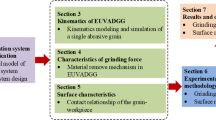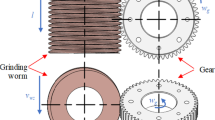Abstract
The surface performance of pump gears has an important influence on the internal flow field, flow rate and flow fluctuation amplitude, instantaneous flow rate, and other performance of the pump during operation. When grinding gear surface with conventional grinding wheel, it is easy to cause over-cutting and edge collapse at the end edge of gear teeth, which is not satisfactory for pump gears. Vibration-assisted abrasive belt grinding can solve the problems of over-cutting and edge collapse at the end face edge of gear teeth caused by conventional grinding and significantly improve the surface performance of gear teeth. However, the method of gear grinding based on vibration-assisted abrasive belt grinding and the law of surface formation have not yet been mastered, so it is difficult to accurately express the surface topography. In this paper, the effects of grinding pressure, vibration frequency, belt linear velocity, and grinding time on surface roughness and surface topography of pump gear during vibration-assisted abrasive belt grinding are studied by single-factor experiment. The experimental results show that in order to synthetically improve the characterization parameters of the surface and improve the surface morphology, the range of parameters should be chosen as follows: grinding pressure (30–50 N), vibration frequency (more than 8 Hz), belt linear velocity (less than 7 m/s), and grinding time (20–40 s).















Similar content being viewed by others
References
Gan XH, Wu XL, Hou DH (2001) Research on performance of hydraulic gear pump. Mech Des Manuf 3:69–70
Chen Y (2011) Research on influence factors and improvements of gear pump. Coal Mine Machinery 2:164–166
Li ZH, Liu XS, Gu GH (1997) Study on the optimization design of pump gear basic parameters. J JiangXi Agric Univ 3:136–140
Du CF (1989) Research on the reverse angle, polishing and burring technology of pump gear. Hydraul Pneum 1:45
Chen M, Sun FH, Lee YM, Yang SH (2004) Surface quality studies with respect to grinding burn of new typical nickel-based superalloy. Key Eng Mater 258-259:233–238
Wang LD, Ling SY, Ma Y, Lou ZF (2009) Processing methods of precision and ultra-precision cylindrical involute gear. Opt Precis Eng 17(02):321–326
Yoshio I, Ryunosuke S, Yoshitaka M, Yoshiteru O, BEN FN (2005) Formation mechanism of finished surface in ultra-high speed grinding with CBN wheels(CBN grinding technology). In: Proceedings of International Conference on Leading Edge Manufacturing in 21st century : LEM21, vol 2005, pp 673–678
Chen X, Wang D, Liu YF (2018) Influence of high speed grinding on surface integrity of 18CrNiMo7-6. Surface Technol 47(09):259–265
Liang ZQ, Huang DQ, Zhou TF, Li HW, Liu XL, Wang XB (2018) Distribution characteristic and simulation analysis on grinding residual stress of spiral bevel gears. J Mech Eng 54(21):183–190
Liu Q, Yang LJ, Tian XL, Wang L, Meng FZ (2018) Distribution characteristic and simulation analysis on grinding residual stress of spiral bevel gears. J Mech Eng 40(03):357–365
Zhuang X, Wang J, Zheng H, Zhao Z (2015) Forming mechanism of ultrasonic vibration assisted compression. Trans Nonferrous Metals Soc China 25(7):2352–2360
Spur G (1996) Holl S-. Ultrasonic assisted grinding of ceramics. J Mater Processing Tech 62(4):287–293
Tang JY, Zhou WH, Huang YL (2016) Modeling on grinding force assisted with axial ultrasonic vibration. Chin J Mech Eng 52(15):184–191
Nik MG, Movahhedy MR, Akbari J (2012) Ultrasonic-assisted grinding of Ti6Al4V alloy. Procedia CIRP 1(1):353–358
Abdullah A, Farhadi A, Pak A (2012) Ultrasonic-assisted dry creep-feed up-grinding of superalloy Inconel738LC. Exp Mech 52(7):843–853
Choi Y, Park K, Hong Y, Kim K, Lee S, Choi H (2013) Effect of ultrasonic vibration in grinding; horn design and experiment. Int J Precis Eng Manuf 14(11):1873–1879
Gao SW, Yang CY, Xu JH, Fu YC, Ding WF, Su HH, Su H (2018) Surface roughness in axial ultrasonic assisted grinding of martensitic stainless steel. J Vibration Shock 37(20):245–250
Zhu DR, Yang JJ, Deng XZ, Guo HJ (2018) Non-resonant design of acoustic system for ultrasonic lapping gear and its verification. J Vibration Eng 31(06):1049–1060
Zhu DR, Deng XZ, Yang JJ, Guo HJ, Liu LN, Li JB (2017) A design of the vibration system of an ultrasonic lapping gear and its experiment. J Vibration Shock 36(20):195–202
Tang J, Zhao B (2018) Design of an ultrasonic machining system based on a special grinding wheel. J Vibration Shock 37(18):132–137
Stadnik T, Sidorov D, Kharchenko A (2017) Investigation of diamond elastic belts characteristics effect on rotary belt grinding process output performance
Li YQ (2018) Ultrasonic vibrating belt grinding technology on complex flow pool. JiLin university
Guo XJ (2017) Study on the technology of ultrasonic vibration assisted belt grinding. JiLin university
Bigerelle M, Gautier A, Hagege B et al (2009) Roughness characteristic length scales of belt finished surface. J Mater Process Technol 209(20):6103–6116
Bigerelle M, Gautier A, Hagege B (2008) Mechanical modelling of micro-scale abrasion in superfinish belt grinding. Tribol Int 41(11):992–1001
Jourani A, Dursapt M, Hamdi H et al (2005) Effect of the belt grinding on the surface texture: modeling of the contact and abrasive wear. Wear 259(7):1137–1143
Segreto T, Karam S, Teti R (2017) Signal processing and pattern recognition for surface roughness assessment in multiple sensor monitoring of robot-assisted polishing. Int J Adv Manuf Technol 90(1-4):1023–1033
Eriksen RS, Arentoft M, Gronbak J et al (2012) Manufacture of functional surfaces through combined application of tool manufacturing processes and robot assisted polishing. CIRP Ann Manuf Technol 61(1):563–566
Xiao GJ, Huang Y, Wang J (2018) Path planning method for the longitudinal micro-marks on the root-fillet of blisk with belt grinding [J]. Int J Adv Manuf Technol 95(1-4):797–810
He Y, Xiao GJ, Li W, Huang Y (2018) Residual stress of TC17 titanium alloy after belt grinding and its impact on the fatigue life [J]. Materials 11(11):221801–221816
Funding
This work was supported by National Natural Science Foundation of China (Grant No. 51705047), the major projects of aero-engines and gas turbines (2017-VII-0002-0095) Technological Innovation and Application Demonstration of Chongqing (cstc2018jszx-cyzdX0061), and Fundamental Research Funds for the Central Universities (2018CDQYCD0038).
Author information
Authors and Affiliations
Corresponding author
Additional information
Publisher’s note
Springer Nature remains neutral with regard to jurisdictional claims in published maps and institutional affiliations.
Rights and permissions
About this article
Cite this article
Huang, Y., Jiahua, S., Xiao, G. et al. Study on the surface topography of the vibration-assisted belt grinding of the pump gear. Int J Adv Manuf Technol 106, 719–729 (2020). https://doi.org/10.1007/s00170-019-04645-7
Received:
Accepted:
Published:
Issue Date:
DOI: https://doi.org/10.1007/s00170-019-04645-7




